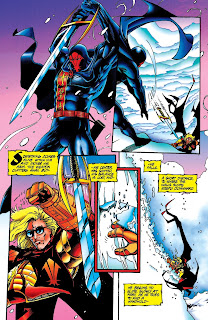After the death of his father, Jean Paul
Valley discovers that he is the latest in a long line of assassins for the
ancient Order of St. Dumas. Taking on the mantle of Azrael, the avenging angel,
Jean Paul comes into direct conflict with Batman and must defeat the man
responsible for killing his father.
Later, an amnesiac Jean Paul must adjust
to a new life after spending time as the Batman. While homeless, he befriends a
former psychiatrist who is penniless and living on the street. Together they
are swept up in a power struggle within the Order of St. Dumas.
Azrael
Volume 1: Fallen Angel collects Batman:
Sword of Azrael #1-4, Showcase '94
#10, and Azrael #1-7, written by
Dennis O’Neil and illustrated by Barry Kitson, Kevin Nowlan, Jim Pascoe and Joe
Quesada.
Fallen
Angel acts as both prelude and epilogue to the seminal Knightfall saga. The
first four issues collected here serve as the origin story for Jean Paul
Valley, introducing him as a slightly nerdy college student who is thus
transformed into a deadly assassin for the Order of St. Dumas. We then jump
immediately to the aftermath of Knightfall where Jean Paul is no longer Batman
and is living on the streets without any memory of what happened to him
previously. From there he goes on a globe-trotting quest to rediscover himself alongside
an alcoholic homeless man and a rogue member of the Order of St. Dumas named
Sister Lilhy. These stories feel very much like high octane James Bond-style
adventures with heavy focus on shifting alliances, maniacal supervillains and
explosive action sequences. Unfortunately, what is lacking amongst the wreckage
created by Azrael in these energetic and fast-paced stories is a sense of
character development.
Jean Paul Valley is bland. O’Neil does
his darnedest to make us care about him, particularly after the mess he became
during Knightfall, but it’s evident that the character is a relic of the 1990s.
For the most part, he’s an unfeeling anti-hero who says very little and spends
most of his time either fighting or brooding. There are glimmers of potential
in him, particularly once we examine his relationships with Brian and Sister
Lilhy. He has affection for them and shows loyalty towards them. However, he’s
most frequently overshadowed by them. Brian’s alcoholism and Lilhy’s marveling at
the world (paired with her sassy dialogue) make them more colourful than the
man who is supposed to be the main character of this book. As such, it makes it
difficult to plod through Fallen Angel with
a character that simply isn’t compelling enough.
Though the writing may be a bit stagnant,
the art in this collection is quite impressive. Joe Quesada handles the four
issue mini-series Batman: Sword of Azrael.
His art is very atmospheric and expressive, but also more subdued than his
often over-the-top work in the pages of X-Factor
roughly from around that same time. Barry Kitson, meanwhile, provides the
pencils for Azrael’s ongoing series. Kitson’s style isn’t quite as
sophisticated as Quesada’s and has a cartoony quality to it, which adds brevity
to each panel. That said, his work is dynamic and he knows how to really set a
scene. His skill at drawing fabrics and drapery is to be commended as well,
particularly when it comes to Sister Lilhy’s robes (seriously, it’s crazy).
Azrael
Volume 1: Fallen Angel feels very much like a product of its time. It’s
overstuffed with action and features an emotionless protagonist who seems
unstoppable. It’s a blockbuster-style book that is all flash, with very little
substance and isn’t as engaging as it could be. O’Neil does touch on some
interesting themes, particularly when he edges towards science, religion and
power. There’s no denying that Azrael
has his share of fans and had an audience (his book did, after all, reach 100
issues), but it’s dated and lacks the characters intricacies (and relatability)
I look for in a superhero comic.
RATING:
C






No comments:
Post a Comment